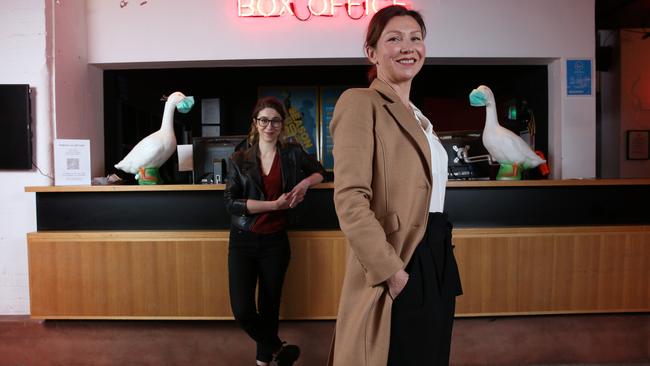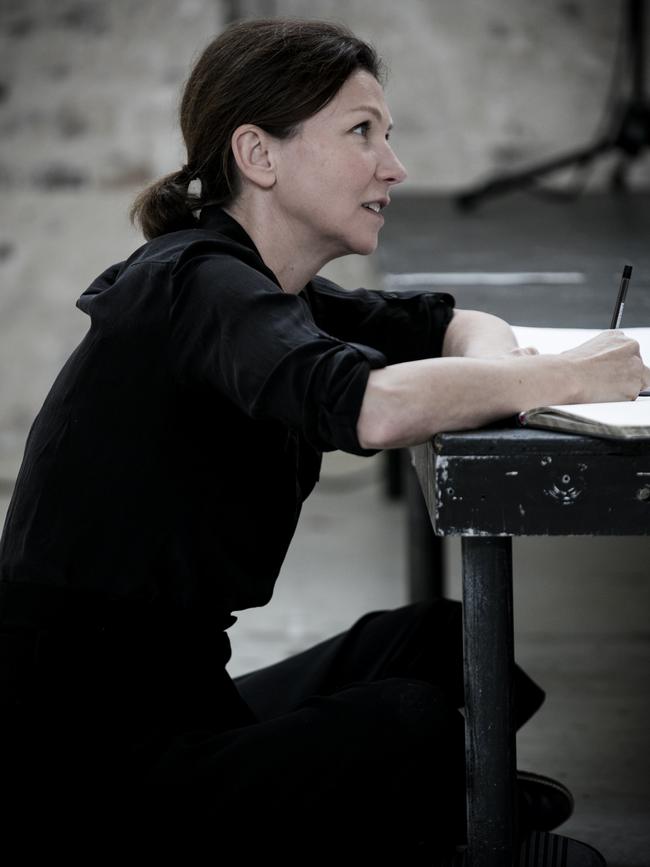Why Belvoir is reopening with Room of One’s Own
Belvoir’s adaptation of Virigina Woolf’s powerful polemic arrives at a time when the idea of personal space — and equal pay — is uppermost in many people’s minds.

The idea of a room of one’s own could be either a blessing or a curse in these COVID-darkened days. Virginia Woolf, in her famous essay, prescribes self-isolation as one of two minimum requirements — the other is a substantial income — if a woman is to have the opportunity to develop her literary talents. As families struggle with home-schooling and WFH, and private space is commandeered as either classroom or office, a room of one’s own can seem a very remote prospect indeed. In other households, the feeling of isolation brought about by the lockdown has been a terrible burden, casting a shadow over any creative impulse.
So Belvoir theatre company’s adaptation of A Room of One’s Own arrives at a time when the possibilities and limitations of personal space are uppermost in many people’s minds. The play, featuring remarkably agile Sydney actress Anita Hegh, was to have opened in April, but has been pushed back to September because of the pandemic. It will be among the first theatre productions to reopen in the city.
READ MORE: Gaslight breaks COVID theatre drought | Hugo Weaving’s daring new play | Glorious sound, deadly threat: a night at the opera | Who’s Afraid of Virginia Woolf still astonishes
A few weeks ago, a rehearsal was presented for a select audience to test how social distancing would work in Belvoir’s 340-seat auditorium. Hegh says there was palpable excitement as people emerged from hibernation and came back to the theatre for the first time in months.
“They hadn’t been to the theatre for five months, and all of us theatre nerds were really excited to be back,” she says. “It’s the lifeblood, I think, for a lot of people.”
Eamon Flack, Belvoir’s artistic director, had the idea of adapting A Room of One’s Own anew for the stage. He offered the project to a young director, Carissa Licciardello, who immediately went away and read it in a single sitting. So many women artists cite Woolf’s essay almost as a feminist manifesto, and Licciardello says she is surprised she hadn’t read it before.
“I just locked myself in a room, and sat down and read it straight through,” she says. “As I was reading it, afternoon was giving way to dusk, was giving way to evening outside — which is what happens in the text. So there was something a little bit magical about the experience of reading it.”
Creating the ultimate feminist text
A Room of One’s Own began as a series of two lectures Woolf gave at Cambridge women’s colleges, Newnham and Girton, in 1928. It came in those few remarkable years in the 1920s in which Woolf produced Mrs Dalloway, To the Lighthouse and Orlando, the last a fantastic biography inspired by her lover at the time, Vita Sackville-West (who accompanied Woolf to the lecture at Girton).
The next year, she produced the work as an essay in six chapters, published by Hogarth Press, which she had founded with husband Leonard Woolf. In it, Woolf sets out her argument that women have been excluded from the seats of learning, the dramatic arts, publishing, indeed, from the fullness of life. They are present in literature only to the extent that they are written into existence by men. In an excerpt from A Room of One’s Own that Hegh reads for Life & Times online, Woolf describes the “queer, composite being” that emerges from her study of women as they are depicted men’s books: “Some of the most inspired words, some of the most profound thoughts in literature fall from her lips; in real life she could hardly read, could scarcely spell, and was the property of her husband.”
Where is the female Shakespeare, she asks, and imagines the figure of Shakespeare’s sister, Judith, who dares to follow her brother into London’s theatres, with devastating consequences. Even those celebrated authors Jane Austen and Charlotte Bronte were hemmed in by circumstance and convention, confined to a woman’s place in the drawing room and not free to broaden their intellectual horizons. It is not until a woman has a room of her own, and an income of 500 pounds a year with which to support herself, that she can burn with the incandescence of a Shakespeare.
Licciardello, who worked on the new theatrical version with Tom Wright, says the fact that A Room of One’s Own was originally a lecture suggests a text made for reading aloud, if not a staged performance. Hegh was convinced by the force of Woolf’s writing but not at first by the prospects of success for the work’s transition to the stage. She’d read the essay when she was a student at Sydney University and dusted off the volume from her bookshelf. As an actor, she habitually reads a text with an ear for changes in emotional register — the dynamics of expression and mood that give shape to a performance — and found Woolf’s prose to be rather restrained.
“She can be a little sarcastic and biting, but her personal journey throughout wasn’t evident to me, reading the essay,” Hegh says. “I thought, Is this dramatic? Is it going to work? Is it too dry for a performance piece? What Tom and Carissa have done with the script is really quite genius … and helps it live and breathe a little more on the stage.”
Hegh is known for her stage and television work, and for roles that involve not a little inner fortitude in the face of abject circumstances. She was Sal Thornhill in The Secret River, the stage adaptation of Kate Grenville’s novel, and Margaret Darcy in Ruth Park’s The Harp in the South, both for Sydney Theatre Company.
The role of a lifetime
She is the latest in a distinguished line of Australians to play Woolf on stage or screen. The most celebrated, of course, is Nicole Kidman’s turn in The Hours, in which she put on a prosthetic nose and went on to win the Oscar for best actress. More recently, Elizabeth Debicki has played Woolf in the film Vita & Virginia, adapted from Eileen Atkins’s play about the couple.
On stage, Woolf has been portrayed by Ruth Cracknell, in a 1997 production of Vita & Virginia, and by Pamela Rabe in a dramatisation of A Room of One’s Own for Melbourne Theatre Company, in 1994.
Licciardello and Hegh have decided their depiction of Woolf will be guided by the writer’s words, and not by an attempt at impersonation — there will be no prosthetic probosces. Similarly, Hegh will deliver the text in what she calls her “Sunday best” stage voice, rather than mimic Woolf’s rather posh, upper middle class accent, as can be heard in recordings.
“What’s important is that her words are uncluttered by the idea of character,” Hegh says. “That’s not the focus. I wasn’t going to be clever and do a Virginia Woolf impersonation — I think that’s reductive, in a way. For her words to speak to an audience … we have to keep it as simple as possible.”
Licciardello says she has directed Hegh’s performance to elucidate Woolf’s intelligence and writerly persona, but with a contemporary voice and energy. “We didn’t want there to be any distance between Virginia’s ideas and what she has to say, and the audience. People can imagine that Woolf is quite haughty and quite removed. But actually what I got from reading the text was wit and great warmth, and obviously massive intelligence — but she wants to share that with you, rather than present it to you.”

A feature of Licciardello’s production will be a second figure on stage, played by Ella Prince, who represents the female creative force Woolf invokes in her essay. Most obviously, she takes the form of Judith Shakespeare, the young woman who had a taste of the theatre, and the “quickest fancy, a gift like her brother’s, for the tune of words”.
In Woolf’s imagination she arrives in London, becomes involved with a theatre manager and finds she is pregnant. It is too much for her — “who shall measure the heat and violence of the poet’s heart when caught and tangled in a woman’s body?” — and she kills herself.
“In many ways it’s the centre point of the production,” Licciardello says of the Judith episode.
“Virginia has gone to the history shelf and hasn’t been able to find much information about

women … so she decides to take a step away from fact and into imagination. She does that by tapping into her own experience as a writer and combining that with what she does know about how women lived back then.
“In reading the text, it felt like once she conjures Judith, this female artistic force is present in it. Virginia stops having to read through everything that men present to her, and starts being able to think through this other woman — who is in some ways like her, and other ways obviously exists in very different times.”
Hegh says Woolf’s polemic has lost none of its power or urgency, even as we approach the centenary of its publication. Woolf exhorted the young women at her lectures to keep the spirit of Shakespeare’s sister alive so “she will be born”.
“What Virginia said still stands,” Hegh says. “A woman must have money and a room of her own. If we are thinking of how we are going to pay the rent, or feed our children, or where we are going to live — if we have material concerns — we don’t have the mental space for creative freedom. If you have money and a roof over your head, you are much more able to explore your artistry … And we are still talking about equal pay, equal work rights.”
A Room of One’s Own is at Belvoir St Theatre, Sydney, September 10-October 18.

To join the conversation, please log in. Don't have an account? Register
Join the conversation, you are commenting as Logout